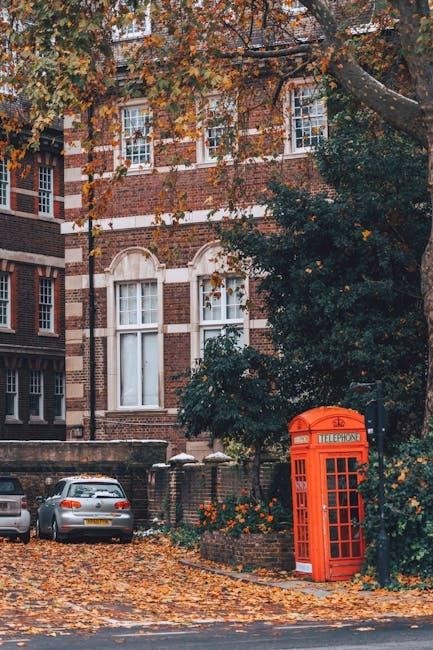The heart is a muscular organ, slightly larger than a fist, functioning as a double pump․ It has four chambers: two atria and two ventricles․ Its anatomy is crucial for understanding blood circulation, oxygenation, and overall cardiovascular health․
1․1 Definition and Overview of the Heart
The heart is a muscular, cone-shaped organ located in the thoracic cavity, functioning as a double pump․ It is slightly larger than a clenched fist and weighs approximately 250-300 grams․ Composed of cardiac muscle, the heart consists of four chambers: two atria (upper) and two ventricles (lower)․ Its primary role is to pump blood through the circulatory system, ensuring oxygenation and nutrient delivery to tissues․ The heart operates as a self-adjusting pump, maintaining blood flow through systemic and pulmonary circuits․ Understanding its anatomy is essential for diagnosing and treating cardiovascular diseases, making it a cornerstone of medical study and practice․
1․2 Importance of Heart Anatomy in Medicine
Understanding heart anatomy is vital for diagnosing and treating cardiovascular diseases․ It aids in identifying structural abnormalities, such as faulty valves or chambers, and guides surgical interventions․ Knowledge of blood flow pathways helps in pinpointing blockages or inefficiencies․ Medical imaging techniques rely on anatomical accuracy to assess heart function․ Surgeons use detailed anatomical maps to perform bypasses or transplants․ Additionally, understanding the heart’s electrical conduction system is crucial for managing arrhythmias․ This foundational knowledge improves patient outcomes, enabling precise treatments and enhancing surgical success rates․ Thus, heart anatomy is a cornerstone of modern medicine and medical education․
Anatomical Structure of the Heart
The heart is a cone-shaped, muscular organ enclosed by the pericardium․ Its wall consists of three layers: the epicardium, myocardium, and endocardium․ Located in the mediastinum, it is surrounded by the pericardial sac, ensuring optimal function․
2․1 Location of the Heart in the Thoracic Cavity
The heart is located in the mediastinum, a central compartment of the thoracic cavity․ It is positioned slightly to the left, behind the sternum, and between the lungs․ The pericardium, a fibrous sac, encloses the heart, anchoring it within the chest․ The heart’s apex points downward and to the left, while its base faces upward and to the right․ This strategic placement allows efficient blood circulation to the lungs and the rest of the body․ The heart is surrounded by vital structures, including the trachea, esophagus, and major blood vessels, ensuring optimal functionality within the thoracic space․
2․2 Pericardium and Its Layers
The pericardium is a fibrous sac surrounding the heart, providing protection and anchorage․ It consists of two layers: the outer fibrous pericardium and the inner serous pericardium․ The fibrous pericardium is tough and attaches the heart to nearby structures, while the serous pericardium secretes a lubricating fluid to reduce friction during heart contractions․ Between these layers lies the pericardial cavity, a space filled with a thin fluid that allows the heart to move smoothly․ This structure ensures the heart operates efficiently within the thoracic cavity, maintaining its position and function while preventing excessive movement or friction․
2․3 Heart Wall: Layers and Composition
The heart wall is composed of three distinct layers: the epicardium, myocardium, and endocardium․ The epicardium is the outermost layer, a thin, fibrous membrane that protects the heart․ Beneath it lies the myocardium, the thickest layer, made of cardiac muscle cells responsible for contraction and pumping blood․ The endocardium is the innermost layer, lining the heart’s chambers and valves, ensuring smooth blood flow and preventing clotting․ Together, these layers work seamlessly to maintain the heart’s structural integrity and functional efficiency, enabling it to pump blood effectively throughout the body․
2․4 External Anatomy: Shape and Surfaces
The heart is a cone-shaped organ, slightly larger than a fist, with a broad base at the top and a pointed apex at the bottom․ Its external surface is protected by the pericardium, a fibrous sac․ The heart’s base is posterior, facing the spine, while the apex points anteriorly, toward the chest wall․ The sternocostal surface, facing the breastbone, is smooth and convex, while the diaphragmatic surface, facing downward, is flatter․ These external features provide structural support and protection, ensuring the heart functions efficiently within the thoracic cavity․
2․5 Internal Anatomy: Chambers and Valves
The heart contains four chambers: the right and left atria, and the right and left ventricles․ The atria are upper chambers that receive blood, while the ventricles are lower, muscular chambers that pump blood out of the heart․ The atrioventricular valves (tricuspid and mitral) regulate blood flow between the atria and ventricles, preventing backflow․ The semilunar valves (pulmonary and aortic) control blood exit from the ventricles into the pulmonary artery and aorta, respectively․ These chambers and valves work together to ensure efficient, one-way blood circulation through the heart․
Chambers of the Heart
The heart consists of four chambers: two atria and two ventricles․ The atria receive blood, while the ventricles pump it out, ensuring efficient blood circulation․
3․1 Right Atrium: Structure and Function
The right atrium is one of the four chambers of the heart, serving as the primary receptor of deoxygenated blood․ Located in the upper right portion of the heart, it receives blood from the superior and inferior vena cava․ The right atrium is a thin-walled chamber with a smooth interior, except for the pectinate muscles that aid in contractions․ Its primary function is to act as a reservoir and pump blood through the tricuspid valve into the right ventricle during diastole․ The sinoatrial node, the heart’s natural pacemaker, is located in its posterior wall, initiating cardiac contractions․
3․2 Left Atrium: Structure and Function
The left atrium is one of the four chambers of the heart, responsible for receiving oxygenated blood from the lungs․ Located in the upper left portion of the heart, it is a thin-walled chamber with a smooth interior․ The left atrium receives blood through the pulmonary veins and pumps it through the mitral valve into the left ventricle during diastole․ Its structure includes a smaller appendage compared to the right atrium, and it lacks pectinate muscles․ The left atrium plays a critical role in maintaining cardiac output by ensuring oxygen-rich blood is efficiently transferred to the left ventricle for distribution to the body․
3․3 Right Ventricle: Structure and Function
The right ventricle is one of the four chambers of the heart, located in the lower right portion․ It receives deoxygenated blood from the right atrium through the tricuspid valve․ The right ventricle is a muscular, thin-walled chamber with a coarse trabeculated interior․ Its primary function is to pump blood through the pulmonary valve into the pulmonary artery, which carries it to the lungs for oxygenation․ The right ventricle plays a crucial role in the pulmonary circuit, ensuring oxygen-depleted blood reaches the lungs․ Its contraction during systole generates the pressure needed for blood to flow into the pulmonary system, making it essential for the cardiac cycle and overall circulation․
3․4 Left Ventricle: Structure and Function
The left ventricle is the strongest and thickest chamber of the heart, located in the lower left portion․ It receives oxygen-rich blood from the left atrium through the mitral valve․ The left ventricle has a thick muscular wall to handle high pressure and pumps blood through the aortic valve into the aorta, the largest artery, supplying oxygenated blood to the entire body․ Its robust structure ensures efficient contraction during systole, maintaining systemic circulation․ The left ventricle is crucial for delivering oxygen and nutrients to tissues, making it central to the body’s metabolic and functional needs․ Its dysfunction can lead to severe cardiovascular conditions, emphasizing its importance in heart health․
Valves of the Heart
The heart contains four valves that ensure blood flows in one direction․ The atrioventricular valves (mitral and tricuspid) regulate blood flow between atria and ventricles, while semilunar valves (aortic and pulmonary) control blood exiting the ventricles into arteries, preventing backflow and maintaining efficient circulation․
4․1 Atrioventricular Valves
The atrioventricular valves, including the mitral (bicuspid) and tricuspid valves, are located between the atria and ventricles․ These valves consist of leaflets, an annulus, chordae tendineae, and papillary muscles․ During systole, they prevent backflow by closing tightly, ensuring blood moves forward․ The mitral valve, with two leaflets, is between the left atrium and ventricle, while the tricuspid valve, with three leaflets, is between the right atrium and ventricle․ Proper function is critical for maintaining efficient blood circulation and preventing conditions like regurgitation or stenosis․ Their structure ensures unidirectional blood flow, essential for cardiac efficiency․
4․2 Semilunar Valves
The semilunar valves, comprising the pulmonary and aortic valves, are located at the exits of the right and left ventricles, respectively․ These valves consist of three cusps that open during systole to allow blood flow into the pulmonary artery and aorta, then close during diastole to prevent backflow․ Their structure includes a fibrous annulus and valve leaflets․ The pulmonary valve directs deoxygenated blood to the lungs, while the aortic valve sends oxygenated blood to the body․ Proper functioning ensures efficient blood circulation and prevents conditions like stenosis or insufficiency․ Their role is critical for maintaining cardiac efficiency and overall cardiovascular health․
Blood Flow Through the Heart
The heart acts as a double pump, circulating blood through pulmonary and systemic circuits․ Deoxygenated blood enters the right atrium, moves to the right ventricle, and flows to the lungs for oxygenation․ Oxygenated blood returns to the left atrium, enters the left ventricle, and is pumped to the body via the aorta․ This continuous cycle ensures efficient oxygen delivery and carbon dioxide removal, maintaining life-sustaining functions․
5․1 Pulmonary Circuit: Pathway and Function
The pulmonary circuit transports deoxygenated blood from the heart to the lungs and returns oxygenated blood․ It begins when deoxygenated blood from the right atrium flows into the right ventricle through the tricuspid valve․ The right ventricle pumps blood through the pulmonary valve into the pulmonary artery, which splits into left and right branches, delivering blood to the respective lungs․ In the lungs, blood picks up oxygen and releases carbon dioxide through capillaries surrounding alveoli․ Oxygen-rich blood returns via pulmonary veins to the left atrium, completing the circuit․ This pathway ensures efficient gas exchange, vital for cellular respiration and overall bodily function․
5․2 Systemic Circuit: Pathway and Function
The systemic circuit delivers oxygenated blood from the heart to the body and returns deoxygenated blood․ It begins with the left ventricle pumping blood through the aortic valve into the aorta, the largest artery․ The aorta branches into smaller arteries, arterioles, and capillaries, supplying oxygen and nutrients to tissues․ Deoxygenated blood collects in venules and veins, eventually returning to the heart via the superior and inferior vena cava, which empty into the right atrium․ This circuit ensures oxygenated blood reaches all body tissues, supporting metabolic processes and maintaining life․ Its proper functioning is essential for overall health and bodily functions․
Conduction System of the Heart
The heart has a specialized electrical system regulating its rhythm․ It includes the sinoatrial node, atrioventricular node, Bundle of His, and Purkinje fibers, ensuring coordinated contractions for efficient blood circulation․
6․1 Sinoatrial Node: The Natural Pacemaker
The sinoatrial (SA) node, located in the right atrium, acts as the heart’s natural pacemaker․ It generates electrical impulses, setting the heart rate and rhythm․ These impulses travel through the atria, triggering contraction․ The SA node’s activity is regulated by the autonomic nervous system, balancing sympathetic and parasympathetic influences to adjust heart rate according to physiological needs․ This intrinsic pacemaker ensures coordinated cardiac contractions, maintaining proper blood circulation․ Its dysfunction can lead to arrhythmias, highlighting its critical role in cardiac function․
6․2 Atrioventricular Node and Bundle of His
The atrioventricular (AV) node is a small group of cells located between the atria and ventricles․ It receives electrical impulses from the atria and delays them, ensuring the ventricles contract after the atria․ The Bundle of His is a collection of specialized fibers that carry the impulse from the AV node to the ventricles․ It splits into the left and right bundle branches, enabling synchronized ventricular contractions․ This system is vital for maintaining a coordinated heartbeat․ Damage to the AV node or Bundle of His can disrupt heart rhythm, leading to conditions like heart block, emphasizing their critical role in cardiac conduction․
6․3 Purkinje Fibers: Role in Ventricular Contraction
Purkinje fibers are specialized conducting cells that play a crucial role in ventricular contraction․ They originate from the Bundle of His and spread across the ventricular walls․ These large, branching fibers rapidly transmit electrical impulses, ensuring synchronized contraction of the ventricles․ This coordination is essential for efficient pumping of blood․ Dysfunction in Purkinje fibers can lead to arrhythmias, highlighting their importance in maintaining normal heart rhythm․ Their unique structure allows for fast conduction, making them a key component of the heart’s electrical system․ This ensures the ventricles contract in unison, optimizing cardiac output and overall circulatory efficiency․
Blood Supply to the Heart
The coronary arteries and coronary veins form the heart’s blood supply․ Coronary arteries originate from the aorta, delivering oxygenated blood to the myocardium, while veins drain deoxygenated blood back to the right atrium․
7․1 Coronary Arteries: Origin and Distribution
The coronary arteries originate from the ascending aorta, just above the aortic valve․ The right coronary artery (RCA) arises from the anterior aortic sinus, while the left coronary artery (LCA) emerges from the left aortic sinus․ The LCA divides into the left anterior descending (LAD) artery and the left circumflex (LCx) artery․ The RCA supplies blood to the right ventricle, the posterior part of the heart, and the sinoatrial node․ The LAD and LCx supply the anterior wall, septum, and lateral wall of the left ventricle, ensuring oxygenated blood reaches all myocardial tissues;
7․2 Coronary Veins: Drainage and Significance
The coronary veins collect deoxygenated blood from the myocardium and drain it into the coronary sinus, which empties into the right atrium․ The great cardiac vein, middle cardiac vein, and small cardiac vein are the primary vessels․ They originate from the capillaries in the heart muscle and converge to form the coronary sinus․ This venous system ensures efficient blood drainage, maintaining cardiac function․ Damage to coronary veins can lead to ischemia or infarction, highlighting their critical role in cardiac health and surgical interventions like coronary bypass grafting․
Cardiac Cycle and Output
The cardiac cycle involves phases of contraction and relaxation, pumping blood efficiently․ Cardiac output, calculated as stroke volume multiplied by heart rate, regulates blood circulation and oxygen delivery․
8․1 Phases of the Cardiac Cycle
The cardiac cycle consists of two main phases: systole (contraction) and diastole (relaxation)․ Systole includes isovolumetric contraction, where ventricular pressure rises, and ventricular ejection, where blood is pumped into arteries․ Diastole involves isovolumetric relaxation, rapid ventricular filling, and diastasis with atrial contraction․ These phases ensure efficient blood circulation, maintaining cardiac output and oxygen delivery to tissues․ Understanding these phases is crucial for diagnosing heart conditions and monitoring cardiovascular health․ The cycle repeats approximately 100,000 times daily, sustaining life through precise coordination of contraction and relaxation․
8․2 Cardiac Output: Calculation and Regulation
Cardiac output (CO) is the volume of blood pumped by the heart per minute, calculated as stroke volume (blood per beat) multiplied by heart rate (beats per minute)․ It is regulated by intrinsic and extrinsic factors․ Intrinsic mechanisms include the Frank-Starling law, where increased preload (venous return) enhances contraction, and autoregulation of afterload (arterial resistance)․ Extrinsic regulation involves the autonomic nervous system, with sympathetic stimulation increasing heart rate and contractility, and parasympathetic stimulation reducing them․ Hormones like epinephrine also boost CO․ These mechanisms ensure optimal blood flow to meet the body’s metabolic demands, adapting to physical activity or stress․
Clinical Significance of Heart Anatomy
Understanding heart anatomy is crucial for diagnosing and treating cardiovascular diseases․ It aids in identifying structural abnormalities, planning surgeries, and guiding interventions to restore normal cardiac function and improve patient outcomes․
9․1 Common Heart Diseases and Their Relation to Anatomy
Common heart diseases often stem from structural or functional anomalies in specific anatomical regions․ Coronary artery disease involves blockages in coronary arteries, impairing blood flow to the myocardium․ Heart failure occurs when ventricles lose efficiency in pumping blood․ Valvular disorders, like stenosis or regurgitation, affect atrioventricular or semilunar valves, disrupting blood flow․ Congenital heart defects, such as septal defects, involve abnormal development of septa or valves․ Arrhythmias arise from malfunctions in the conduction system, such as the sinoatrial node; Understanding these conditions requires a deep knowledge of heart anatomy, enabling precise diagnoses and targeted treatments to restore normal cardiac function and improve patient outcomes․
9․2 Surgical Interventions Based on Heart Anatomy
Surgical interventions often target specific anatomical structures to restore cardiac function․ Coronary artery bypass grafting involves rerouting blood flow around blocked coronary arteries, while heart transplants replace a diseased heart with a healthy one․ Valve repair or replacement addresses faulty atrioventricular or semilunar valves, ensuring proper blood flow․ Septal defect closures correct congenital anomalies in the heart’s septa․ Surgeons use detailed anatomical knowledge to navigate structures like the pericardium, myocardium, and chambers․ Minimally invasive techniques, such as robotic surgery, leverage precise anatomical mapping to minimize tissue damage․ These procedures highlight how understanding heart anatomy is critical for effective surgical outcomes and patient recovery․



About the author